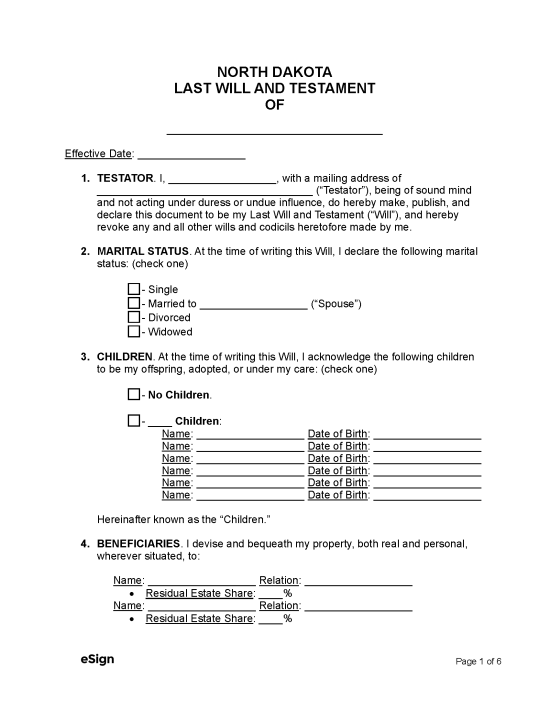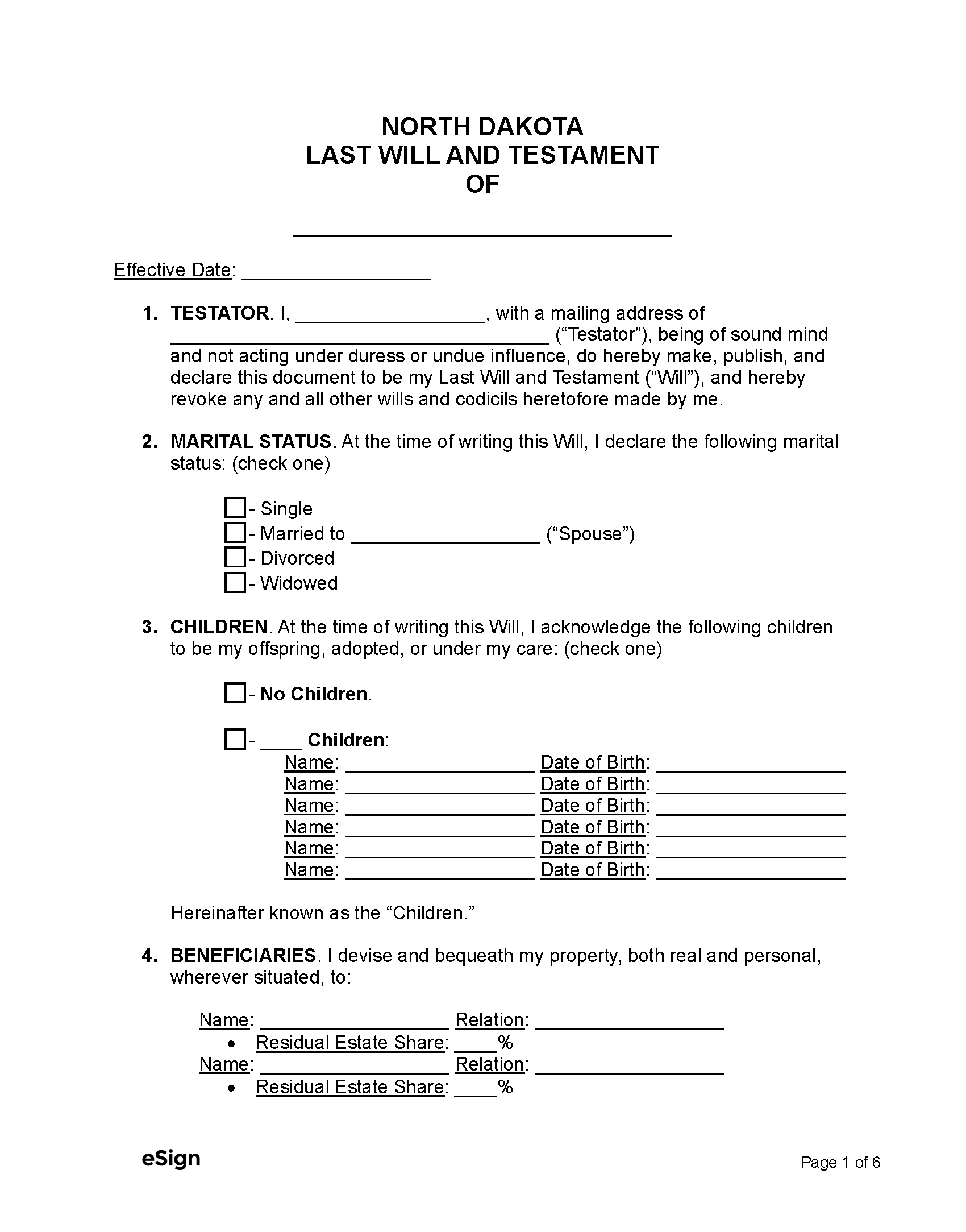State Laws
Any mentally competent adult has the ability to create a will.[1]
Holographic Wills – A handwritten (holographic) will is valid if the signature and contents of the document are in the testator’s handwriting.[2]
Revocation – A will may be canceled by executing a new will or performing a “revocatory act on the will,” which includes burning, tearing, and destroying the original.[3]
Signing Requirements – To be valid, a will must be signed by the testator and either:[4]
- Signed by two witnesses; or
- Acknowledged by the testator in the presence of a notary public or other person qualified to take acknowledgments.
Probate Process in North Dakota (10 Steps)
Before distributing property to beneficiaries, the person in charge of administering the estate must ask the court to confirm the validity of the will and recognize their authority to serve as the decedent’s personal representative. This legal process, known as “probate,” may be started five days after the testator’s death.[5]
- Check Eligibility for Informal Probate
- File Informal Probate Documents
- Notify Heirs and Devisees
- Prepare an Inventory of Assets
- Publish Notice to Creditors (Optional)
- Mail Documents to the Department of Human Services
- Pay Claims Against the Estate
- Pay Estate Tax
- Distribute the Estate
- File Closing Statement
1. Check Eligibility for Informal Probate
If the estate is worth $50,000 or less and contains no real property, the beneficiaries can avoid probate by filing an Affidavit for Collection of Personal Property of the Decedent (also called a “small estate affidavit”).[6]
North Dakota district courts use both formal and informal probate procedures. Informal probate is cheaper, less time-consuming, and doesn’t require a court hearing. However, a formal probate proceeding will be necessary if any of the following apply:[7]
- Three years have passed since the decedent’s death.
- Someone contests the validity of the will.
- Someone objects to the informal probate process.
The rest of this guide will help users understand the procedures for informal probate, including the forms that must be filed with the district court and the deadlines by which specific actions must be taken.
2. File Informal Probate Documents
Once five days have passed since the decedent’s death, the personal representative can start the informal probate process by submitting the following documents to the district court in the county where the decedent lived:
- Application for Informal Probate of Will and Appointment of a Personal Representative (Form 2)
- Statement of Informal Probate of Will and Appointment of a Personal Representative (Form 3)
- Letters Testamentary (Form 4)
- Decedent’s Original Will
- Certified Death Certificate – Not always required.
- $80 filing fee
Note: An Affidavit for Access to Safe Deposit Box (Form 8) is required if the personal representative needs to open a safe deposit box to retrieve the decedent’s will or personal property.
3. Notify Heirs and Devisees
Once the probate documents are submitted, the district court will formally appoint the personal representative to manage the estate by signing the Letters Testamentary. Within 30 days after their appointment, the representative must fill out a Notice and Information to Heirs and Devisees (Form 5) and mail a copy to each heir and devisee.[8]
4. Prepare an Inventory of Assets
It’s the personal representative’s job to locate the decedent’s assets and prepare an Inventory and Appraisement (Form 10) to identify the value of each item in the estate.
Within six months after the date of their appointment or nine months after the decedent’s death, whichever is later, the personal representative must either file the Inventory and Appraisement with the district court or mail a copy to each devisee and anyone else who requests it.[9]
5. Publish Notice to Creditors (Optional)
Personal representatives should, but aren’t required to, publish a Notice to Creditors (Form 6) to advise creditors of their right to file claims against the estate.[10] The notice must be published once a week for three consecutive weeks in a newspaper accessible in the county where the court is located. Once published, the newspaper will provide proof of publication, which the personal representative must file with the court.
If the personal representative decides to publish the notice, they must also send a copy of the Notice to Creditors to known creditors who haven’t submitted a claim yet.
Deadline for Filing Claims Against the Estate
Creditors must file their claims within three months after the date of the initial publication or mailing of the notice.[11]
If the personal representative chooses not to publish the notice, creditors are allowed a maximum of three years from the date of death to submit claims against the estate.
6. Mail Documents to the Department of Human Services
The personal representative must mail an Affidavit Forwarding Application to Human Services (Form 7), a copy of the Application for Informal Probate, and a list of the beneficiaries and any surviving joint tenants (co-owners of the decedent’s property) to the following address:[12]
Department of Human Services
State Capitol
Bismarck, ND 58505
Mailing must occur at the time the Notice to Creditors was published (if applicable). If publication didn’t happen, the paperwork should be mailed soon after the district court’s appointment of the personal representative.
7. Pay Claims Against the Estate
After waiting three months from the date the Notice to Creditors was first published or mailed (or three years after the decedent’s death if no notice was published/mailed), the personal representative can pay off claims filed against the estate by the decedent’s creditors. In North Dakota, claims must be paid in the following order:[13]
- Administration expenses
- Funeral costs
- Debts and taxes that hold priority according to federal law
- Medical and hospital expenses incurred during the decedent’s last illness, including compensation for individuals who provided care
- Outstanding child support payments
- Debts and taxes that hold priority according to other North Dakota laws
- All other claims
It may be necessary for the personal representative to sell some of the decedent’s assets to cover what’s owed. If selling real property, a Personal Representative’s Deed (Form 12) must be submitted to the county recorder along with a copy of the Letters Testamentary, certified on or after the date of the deed’s execution.
Note: All financial transactions involving the estate must be documented in the Record of Receipts and Disbursements of Personal Representative (Form 14).
8. Pay Estate Tax
Depending on how much the decedent’s property is worth, a federal estate tax return may need to be filed and paid by the personal representative. If required, the estate tax return must be filed within nine months after the date of death.
If a federal estate tax return is filed, the personal representative will also be responsible for the following tax obligations:
- File a North Dakota Estate Tax Return within 15 months after the decedent’s death.[14]
- If the estate received income throughout the tax year, file a Fiduciary Income Tax Return.
9. Distribute the Estate
Once the necessary documents are filed, and all taxes and debts are settled, the personal representative can distribute the estate assets according to the decedent’s will. Each distribution must be reported in the appropriate form provided below:
- Personal Representative’s Assignment (Form 13) – Required for distributions of personal property; must be filed with the court.
- Personal Representative’s Deed of Distribution (Form 11) – Required for distributions of real property; must be recorded at the county recorder’s office along with a copy of the Letters Testamentary, which must be certified on or after the date of the deed.
A full report of each distribution made by the personal representative must be documented in writing and provided to the beneficiaries.
10. File Closing Statement
To complete the informal probate process, the personal representative will need to file one of the following closing statements with the court:
- Personal Representative’s Verified Statement to Close Estate (Form 15) – For use if a Notice to Creditors has been published.
- Sworn Statement of Personal Representative Closing a Small Estate (Form 16) – For use if a Notice to Creditors has not been published AND the estate qualifies as a “small estate.” [15]
If a Notice to Creditors was not published and the estate doesn’t qualify as a “small estate,” the personal representative must draft their own closing statement that includes the information required by state law (no official form is available).[16]
A copy of the closing statement must be mailed to the beneficiaries and any creditor with an active claim that could not be paid. The estate will officially close if no legal actions are brought against the personal representative within one year after filing the closing statement.

